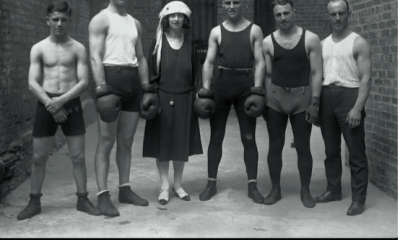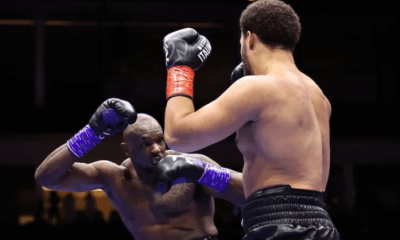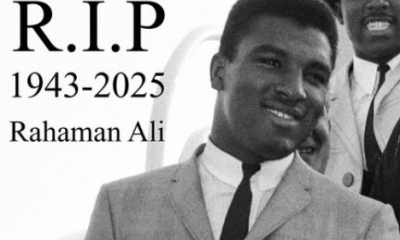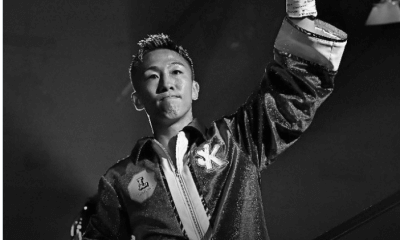Articles
Carl “The Truth” Williams Was A Study in Contradictions
 So little actual time elapsed. So many memorable quotes uttered.
So little actual time elapsed. So many memorable quotes uttered.
Boxing can be funny that way. Sometimes, so many say so much about so little. Gary Cooper “strong, silent types” are a rare commodity in a sport where bragging about what you expect to do (beforehand) or what you might have done (after you fail to do it) is common. Now or then, everyone has a detailed explanation – or an excuse – for what we all saw with our own eyes. Some of what is said is even a little bit believable, if not the absolute truth.
The announcement of former heavyweight contender Carl “The Truth” Williams’ death at 53 on April 7, after a prolonged battle with esophageal cancer, reminded me of the taunt-filled prelude to, and defiant aftermath, of Williams’ first-round technical knockout by undisputed champion Mike Tyson on July 21, 1989, in Atlantic City’s Boardwalk Hall. It also is a reminder that what seemingly is apparent to all can really be nothing more than an illusion.
Controversy? Yeah, well, maybe some, particularly if you were of the opinion that the 6-foot-4 Williams, with an imposing 14-inch reach advantage, might have survived Iron Mike’s furious early onslaught, found his rhythm and employed that telephone-pole of a jab to overcome the 12-1 odds against him and pull off a monumental upset.
Williams, in fact, had already landed several stiff jabs before he threw one that missed. Tyson ducked underneath it and surged upward with a left hook that caught the challenger flush on the jaw. Williams went down in a heap, the back of his head bouncing off the bottom strand of the ropes.
Three hundred an ninety days earlier, in the very same arena, Michael Spinks had gone down with a thud after being tagged with another Tyson first-round missile. Some observers thought Spinks might have beaten the count that night, but elected not to try. After being run over by a truck, you don’t whistle for the driver to back up and do it again.
To his credit, Williams struggled to his feet at the count of seven. But referee Randy Neumann, not liking what he saw in Williams’ seemingly unfocused eyes, waved the fight off only 93 seconds after the opening bell.
Williams, whose previous claim to fame had come in giving then-champion Larry Holmes all he could handle in losing a close, 15-round unanimous decision on May 20, 1985, in Reno, Nev., claimed in the postfight press conference that he had been the victim of a premature stoppage.
“I’ve been down before, got up and rose to the occasion,” Williams said, noting that he had been floored a total of seven times in bouts with James “Quick” Tillis, Jesse Ferguson and Mike Weaver, but had managed to come away with victories over Tillis and Ferguson. “(Neumann) said to put up my hands. I put up my hands. He asked me if I was all right. I said, `Sure.’ What was there, a one-knockdown rule? This is a heavyweight championship fight. I should get the benefit of the doubt.”
Neumann, who had been a promising heavyweight prospect in his own right in the early 1970s, having mixed it up with Jerry Quarry, Jimmy Young, Duane Bobick and Chuck Wepner (three times), had a different take.
“I asked him, `Are you all right?’” Neumann said of his attempt to ascertain Williams’ fitness to continue. “The first time I asked him there was no response and his eyes looked rather blank. I asked him a second time. Again, no response. I stopped the fight. The man clearly was concussed. He couldn’t answer a very simple question verbally, and his eyes told me a story that he was not in good shape.”
Williams’ veteran trainer, Carmen Graziano, opined that Neumann had pulled the plug on his guy too quickly because the snarling guy standing in the neutral corner, ready to charge out and fire more haymakers, was a monster puncher everyone then considered to be what he claimed to be, namely the baddest man on the planet.
“When Mike Tyson knocks somebody down,” Graziano conceded, “some referees are more inclined to stop a fight just because he’s Mike Tyson.”
Whether or not Williams could have weathered that early storm seemed a moot point to the 11,112 spectators and a phalanx of media members who were totally buying into the notion that the 23-year-old Tyson was as close to unbeatable as it ever gets in boxing. And, I have to admit, I also was a passenger on that crowded bandwagon. My report in the Philadelphia Daily News suggested that what had happened to Spinks and Williams was going to happen over and over, possibly for a good many more years.
Considering that Tyson … continues to cut down contenders like a scythe in tall grass, his reign might last into the 21st century. Although there is no shortage of heavyweights who would volunteer – for a substantial fee, of course – to be beaten up by Tyson, the man who is capable of ending his reign might not even be a man yet. He might be in grade school somewhere, taking his classmates’ lunch money.
Williams’ complaints, as might be expected, merely served as backdrop to Tyson’s chest-thumping, which, in retrospect, would seem to have been eerily prophetic. Noting that Evander Holyfield had knocked out a world-rated Brazilian heavyweight, Adilson Rodrigues, in the second round just six day earlier in Lake Tahoe, Nev., Tyson dismissed Holyfield as another prospective victim whose fate would be no different than the one just suffered by Williams.
“Yeah, he can come get some,” Tyson said of Holyfield. “I’m sure he would find it very stimulating. I would love to fight Holyfield. Right now. Today. Tonight. In the ring, out of the ring.
“Let’s get it on. If he thinks he can beat me, we can go down in the cellar. The one who comes back with the key is the champion.”
The prevailing sentiment was that, in the ring or down in the cellar, Tyson held the key and wasn’t going to hand it over to anyone until he was damn good and ready. But Tyson also said something during his time at the podium that was even more telling.
“No man is invincible,” he said, in what many of us thought was a half-hearted and unconvincing attempt at humility. “One day I won’t be champion. One day somebody will beat me, or else I’ll retire. Then you guys (reporters) will have a lot to write. But you’re going to have to live with the way I am until that day happens.”
That day, as it turned out, was a lot closer than anyone could have anticipated. In Tyson’s very next bout, 311 days after he disassembled Williams, he himself was taken apart by an apparent no-chance challenger whose attributes were not unlike those of “The Truth.” And when a 42-1 longshot named Buster Douglas shocked the world on Feb. 11, 1990, in Tokyo, knocking out Tyson in 10 rounds, what had transpired in the Tyson-Williams fight took on a completely different perspective.
Had so many of us been wrong in our assessment of the Tyson that had been on display until his denouement in Japan? When Tyson finally did go down into that cellar with Holyfield, admittedly eight years after it probably should have happened, it was Holyfield who twice came up with the key.
Maybe the young Tyson was never as indestructible as his legion of backers had convinced themselves he was. Maybe he would have been all that and more, had not his consumptive lifestyle robbed him of much of what had made him so very special. And maybe, had Douglas fought him in Atlantic City on July 21, 1989, and Williams had been his opponent on Feb. 11, 1990, in Tokyo, Douglas would now be a footnote to history and Williams would be the celebrated first conqueror of Godzilla.
Randy Gordon, the former editor of The Ring and former chairman of the New York State Athletic Commission, fondly remembered Williams when asked to comment on his passing by boxing writer Lyle Fitzsimmons.
“To me he was a fighter who came along at the wrong time – right between Larry Holmes and Mike Tyson,” Gordon said. “I have no doubt that if Williams were fighting today he’d be the one guy capable of upsetting the Klitschko brothers and certainly capable of teaching the rest of the division how a heavyweight should use the jab.”
There probably is at least a scintilla of justification for Gordon’s praise of “The Truth,” who retired in October 1997 with a 30-10 record that included 21 wins inside the distance. It’s conceivable everything all have turned out differently for him in a different time or under different circumstances. But the record is what the record is, and speculation and conjecture can’t change it.
Williams does take to the grave those 15 heroic rounds against Holmes, and a minute or so against Tyson when he at least attempted to give as good as he got.
“I have great admiration for him,” Tyson said after his TKO victory. “That’s how you should fight when you fight for the heavyweight championship of the world. You should try to take it. Don’t run around the ring and pitty-pat for it.”
-

 Featured Articles3 weeks ago
Featured Articles3 weeks agoThe Hauser Report: Cinematic and Literary Notes
-

 Featured Articles4 weeks ago
Featured Articles4 weeks agoOscar Duarte and Regis Prograis Prevail on an Action-Packed Fight Card in Chicago
-

 Book Review3 weeks ago
Book Review3 weeks agoMark Kriegel’s New Book About Mike Tyson is a Must-Read
-

 Featured Articles1 week ago
Featured Articles1 week agoThe Hauser Report: Debunking Two Myths and Other Notes
-

 Featured Articles2 weeks ago
Featured Articles2 weeks agoMoses Itauma Continues his Rapid Rise; Steamrolls Dillian Whyte in Riyadh
-

 Featured Articles4 weeks ago
Featured Articles4 weeks agoRahaman Ali (1943-2025)
-

 Featured Articles4 weeks ago
Featured Articles4 weeks agoTop Rank Boxing is in Limbo, but that Hasn’t Benched Robert Garcia’s Up-and-Comers
-

 Featured Articles3 weeks ago
Featured Articles3 weeks agoKotari and Urakawa – Two Fatalities on the Same Card in Japan: Boxing’s Darkest Day














